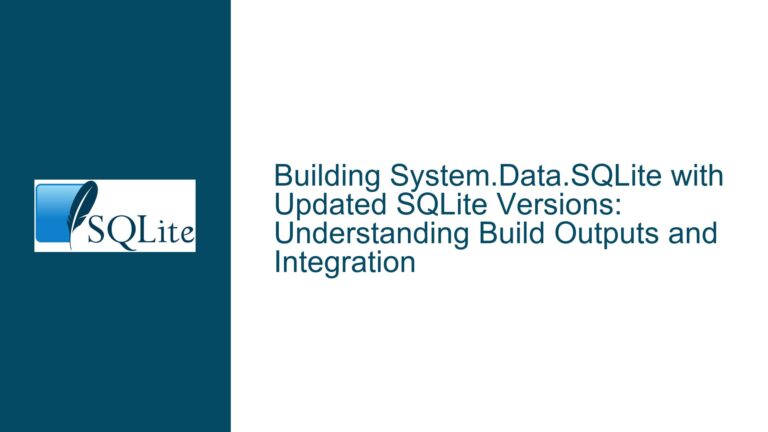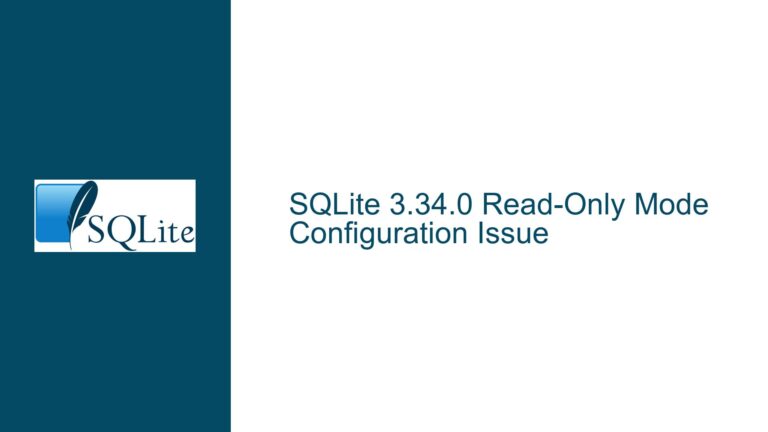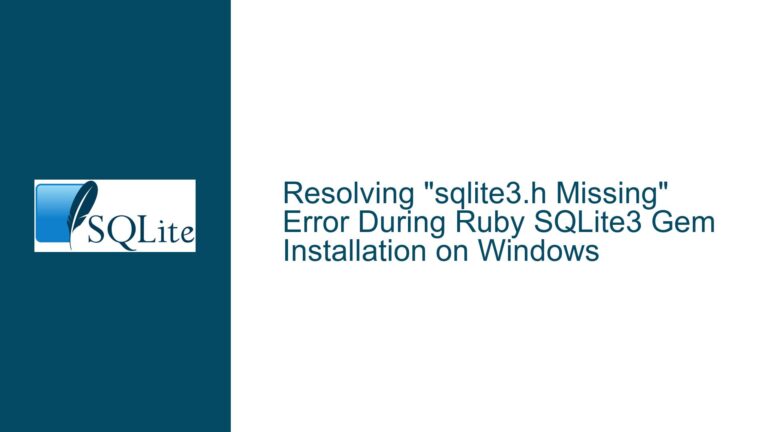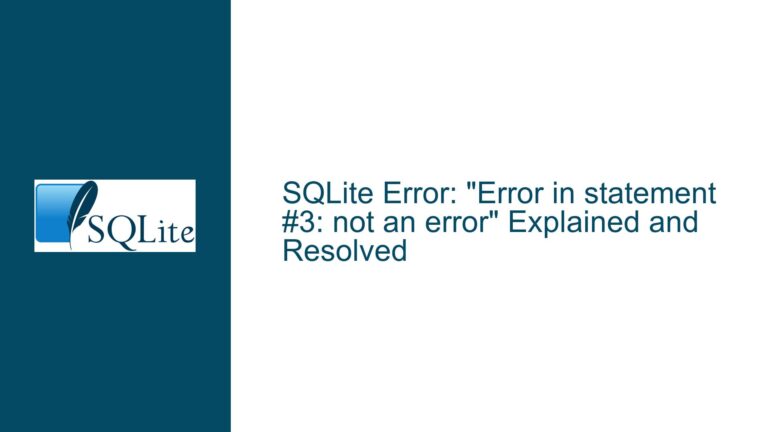Enhancing SQLite .dump Command with Optional Table Drops
Issue Overview: The Need for Conditional Table Drops in SQLite .dump Output
The SQLite .dump command is a powerful tool for exporting database schemas and data into a text format, which can be used for backups, migrations, or transferring data between databases. However, the current implementation of .dump has a limitation when it comes to handling changes in table structures during data transfers. Specifically, the .dump command generates SQL statements that include CREATE TABLE commands without first dropping the existing tables. This can lead to issues when the table structure in the source database has changed, and the destination database already contains a table with the same name but a different structure.
In such scenarios, the .dump output will attempt to create a table that already exists, resulting in an error unless the destination table is manually dropped beforehand. This limitation is particularly problematic in environments where database schemas evolve over time, and frequent data transfers are required between databases with potentially differing table structures. The current workaround involves manually editing the .dump output or running additional commands to drop tables before importing the data, which is both time-consuming and error-prone.
The core issue here is that the .dump command does not provide a built-in mechanism to conditionally drop tables before creating them. This functionality would be particularly useful in scenarios where the table structure in the source database has changed, and the destination database needs to be updated accordingly. Without this feature, users are forced to resort to manual interventions or external scripting to achieve the desired behavior, which undermines the efficiency and reliability of the .dump command.
Possible Causes: Why the Current .dump Implementation Falls Short
The current behavior of the .dump command is rooted in its primary design goal: to generate a complete and accurate representation of the database schema and data. The command outputs SQL statements that can be used to recreate the database from scratch, including CREATE TABLE statements for all tables and INSERT statements for all rows. However, this design does not account for the possibility that the destination database might already contain tables with the same names but different structures.
One reason for this limitation is that the .dump command is intended to be a general-purpose tool, suitable for a wide range of use cases. Adding conditional logic to drop tables before creating them would introduce additional complexity and potentially unexpected behavior in some scenarios. For example, if a user accidentally runs the .dump output twice on the same database, the second run would drop and recreate all tables, potentially leading to data loss or other unintended consequences.
Another factor is the historical context of SQLite’s development. SQLite was originally designed as a lightweight, embedded database engine, with a focus on simplicity and ease of use. The .dump command was created as a straightforward way to export and import data, without the need for complex configuration options. Over time, as SQLite has been adopted for more diverse and demanding use cases, the limitations of the .dump command have become more apparent, particularly in environments where database schemas are subject to frequent changes.
Additionally, the lack of a built-in mechanism to drop tables before creating them reflects a broader design philosophy in SQLite: to provide a minimalistic set of features that can be extended or customized by users as needed. While this approach has many advantages, it also means that certain common use cases, such as the one described here, are not addressed out of the box, requiring users to implement their own solutions.
Troubleshooting Steps, Solutions & Fixes: Implementing Conditional Table Drops in .dump Output
To address the limitations of the current .dump command, there are several approaches that can be taken, ranging from manual workarounds to more automated solutions. Each approach has its own advantages and trade-offs, and the best choice will depend on the specific requirements and constraints of the use case.
Manual Editing of .dump Output
One straightforward solution is to manually edit the .dump output to include DROP TABLE statements before the corresponding CREATE TABLE statements. This can be done using a text editor or a script that processes the .dump file. For example, the following sed command can be used to insert DROP TABLE statements before each CREATE TABLE statement:
sed 's/CREATE TABLE IF NOT EXISTS \(.*\) (/DROP TABLE IF EXISTS \1;\n&/' dumpdb.sql
This command uses a regular expression to match CREATE TABLE statements and insert a corresponding DROP TABLE statement before each one. The DROP TABLE IF EXISTS syntax ensures that the command will not fail if the table does not already exist. While this approach is effective, it requires manual intervention and may not be suitable for automated or large-scale use cases.
Custom Scripting for Automated Table Drops
For more automated solutions, custom scripts can be written to preprocess the .dump output and add the necessary DROP TABLE statements. These scripts can be written in a variety of programming languages, such as Python, Perl, or Bash, depending on the user’s preferences and the specific requirements of the use case. For example, a Python script could be used to read the .dump file, insert DROP TABLE statements, and write the modified output to a new file:
import re
with open('dumpdb.sql', 'r') as infile, open('dumpdb_modified.sql', 'w') as outfile:
for line in infile:
if re.match(r'CREATE TABLE IF NOT EXISTS', line):
table_name = re.search(r'CREATE TABLE IF NOT EXISTS (\w+)', line).group(1)
outfile.write(f'DROP TABLE IF EXISTS {table_name};\n')
outfile.write(line)
This script reads each line of the .dump file, checks if it is a CREATE TABLE statement, and if so, inserts a corresponding DROP TABLE statement before writing the line to the output file. This approach provides more flexibility and can be easily integrated into automated workflows.
Proposing a New Feature for the .dump Command
A more robust and long-term solution would be to enhance the .dump command itself to include an option for conditional table drops. This could be implemented as a new command-line switch, such as --drop-tables, which would modify the output to include DROP TABLE statements before each CREATE TABLE statement. For example:
sqlite3 source.db ".dump --drop-tables" > dumpdb.sql
This command would generate a .dump file that includes DROP TABLE statements, making it easier to transfer data between databases with evolving schemas. The implementation of this feature would require modifications to the SQLite source code, but it would provide a more user-friendly and reliable solution for this common use case.
Considerations for Implementing the New Feature
When implementing the --drop-tables switch, several considerations should be taken into account to ensure that the feature is both useful and safe. First, the switch should be optional, allowing users to choose whether or not to include DROP TABLE statements in the .dump output. This would preserve the current behavior for users who do not need this functionality.
Second, the switch should be designed to handle edge cases gracefully. For example, if a table is dropped and then recreated, any associated indexes, triggers, or constraints should also be recreated to ensure that the database remains consistent. This may require additional logic to generate the necessary SQL statements in the correct order.
Finally, the implementation should be thoroughly tested to ensure that it does not introduce any regressions or unexpected behavior. This includes testing with a variety of database schemas, including those with complex relationships between tables, as well as testing in different environments and with different versions of SQLite.
Conclusion
The current limitations of the SQLite .dump command can be addressed through a combination of manual workarounds, custom scripting, and proposed enhancements to the command itself. Each approach has its own advantages and trade-offs, and the best choice will depend on the specific requirements and constraints of the use case. By implementing a new --drop-tables switch, SQLite could provide a more robust and user-friendly solution for transferring data between databases with evolving schemas, reducing the need for manual interventions and improving the overall efficiency and reliability of the .dump command.






